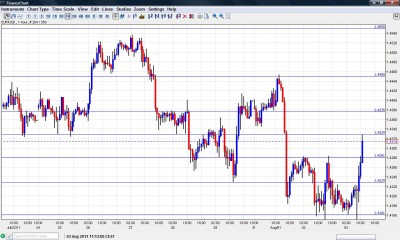Euro dollar managed to break resistance, after two failed attempts. European retail sales rose by 0.9%, better than 0.5% that was expected. The Swiss move to curb the strength of the franc, also against the euro also pushes EUR/USD higher. Also a “ceasefire” from the bond vigilantes helps. It bounced off a higher resistance line. Is this temporary before the next move downwards?
Here’s a quick update on technicals, fundamentals and what’s going on in the markets.
EUR/USD Technicals
- Asian session: A very quiet session saw the pair moving above the 1.4160 line. The attempt on 1.4282 began in the European session.
- Current range 1.4282 to 1.4225.
- Further levels in both directions: Below 1.4282, 1.4230, 1.4160, 1.41, 1.4070, 1.4030, 1.3950, 1.3838, 1.37.
- Above: 1.4325, 1.4375, 1.4450, 1.4550, 1.4650, 1.47, 1.4775.
- 1.4282 is a double top, that proved to be very strong.
- 1.4160 support is the key for the downside.
- Note that significant support is above the round 1.40 line, at 1.4030, in case of another sharp drop.
Euro/Dollar trading in lower range – click on the graph to enlarge.
EUR/USD Fundamentals
- 8:00 European Final Services PMI. Exp. 51.4. Actual 51.6.
- 9:00 European Retail Sales. Exp. +0.5%. Actual +0.9%.
- 11:30 US Challenger Job Cuts.
- 12:15 US ADP Non-Farm Payrolls.
- 14:00 US ISM Non-Manufacturing PMI. Exp. 53.8 points. See how to trade this event with EUR/USD.
- 14:00 US Factory Orders. Exp. -0.4%.
* All times are GMT.
For more events later in the week, see the Euro to dollar forecast
EUR/USD Sentiment
- Finally some good news: European consumers are spending more than expected. The rise in retail sales, that comes not only from Germany and France, is one positive figure in the sea of red. This made the break.
- The SNB had enough: The Swiss National Bank didn’t directly intervene in the markets. They know they would lose. What they did do to curb the extreme strength, is to cap interest rates, and even make them negative, not for the first time in history. The weakness that was triggered in the Swiss franc affects the euro.
- Spanish troubles: Spanish 10 year bond yields are stable at 6.2% at the moment, after hitting 6.45% yesterday. This is too close to 7% – the magic number that sent previous countries to bailouts. But Spain is too big to bail. Spain is set for a downgrade very soon by Moody’s, as expected. General elections were pushed forward by the government, and they are expected in November now. In the meantime, Deutsche Bank ditches Spain and other countries in the periphery. Spanish prime minister cancelled his vacation.
- Italian woes: Italian 10 year bond yields are above 6%, but lower than yesterday. This is Europe’s third largest economy. There is some speculation that the Italian prime minister Berlusconi will resign. Despite all the agreements, doubt about the results is beginning to appear. The EFSF (bailout fund) will probably have the powers to intervene in the bond markets only towards the end of the year. This is a very long time. German finance minister Wolfgang Schaeuble said he is “against a carte blanche for the euro zone’s rescue fund to purchase bonds on the secondary market”. This mechanism is the key for preventing further bailouts. Italy raised money in the markets, but had to settle for higher yields and a sum that was smaller than expected. It isn’t only the price of bonds, but this already affects new funding and may become unsustainable . There are worrying signs in Europe.
- Debt Hike Deal passes first hurdle: Intense negotiations towards the official “drop dead date” of August 2nd (which is today) came to a conclusion in the eleventh hour and a deal was announced and passed through the House. The Senate will now approve it, and it will follow for finalization at the White House. Things can still go wrong in the last moment, but the chances are slim. The limited compromise will likely send some of the rating agencies to downgrade the credit rating of the US, although we might have a split rating: S&P can lower the rating to AA, while Fitch and Moody’s might leave it on AAA. Some tough love for the US.
- Horrible US data: The American manufacturing sector is almost at a standstill. These are fresh figures for July, that provide hints for the Non-Farm Payrolls. This joins bad GDP data. Not only did the US grow less than expected in Q2 2011, but Q1 was unexpectedly revised to a growth rate of only 0.4%. This triggered worries that Ben Bernanke could hit the printing presses once again, with QE3, after ruling it out not so long ago. Today we have data from a more important sector: the services sector. Here is a preview of the event and 5 scenarios to trade it with euro/dollar.
- Slowdown in prices: . Recent PPI data joins Flash CPI estimates released on Friday in showing that inflation has weakened. Will Trichet soften his tone in the rate decision on Thursday? What Trichet really needs to do is print money, and become a super hero like Jean-Claude Van-Damme.

